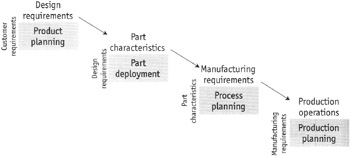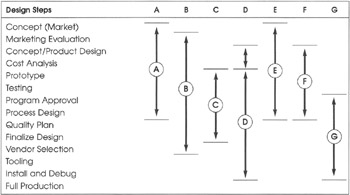Quality function deployment (QFD)
|
QFD is a systematic way of ensuring that the development of the features, characteristics and specifications, as well as the selection and development of process equipment, the methods and controls of a product or service are driven by the demands of the customer or marketplace. The term development of a product includes several things: applying new technology, combining existing and new technology and improving quality of performance.
From a QFD perspective, planning is determining what to make and designing is deciding how to make it. Both are important and both depend on the level and the degree of understanding the customer's wants and needs and the product in question. Whereas the traditional approach of transferring the customer's wants into engineering requirements is using the house of quality approach, in this section of the methodology we are going to present a somewhat more detailed, yet systematic, approach based on the work of Clausing and Hauser (1988), as well as the work of Akao (1990). The idea here is to demonstrate that QFD can actually be used, not only in the appraisal mode of quality, but also in the planning mode of quality. (We make the differentiation of the traditional QFD methodology in the DMAIC model and the QFD approach as used in the DCOV model. The first is very common, whereas the second is not used extensively.)
The foundation of any QFD study is the usage of several quality charts. Of course, these charts may be defined broadly or narrowly. Broadly, we can say that a quality chart is a matrix or series of matrices used to correlate everything from product design plan through the quality control process chart, including what we have called the house of quality chart. In a more narrow definition we can define it as a two dimensional matrix consisting of a demanded quality chart combined with a quality characteristics deployment chart. The traditional approach of QFD is shown in Figure 6.1.

Figure 6.1: The traditional approach of QFD
The value of this approach is its ability to trace the wants of the customer all the way to manufacturing. This approach is very effective for certain parts and components, but awkward for computers, automobiles and other complex systems. It is good for minor improvements in existing technology, but is not well suited for cost-effective innovation.
A more generic approach was developed by Yoji Akao in the mid 1980s and refined in 1990. Its value was that it included linkages with value engineering and reliability charts such as FMEA and FTA. This was adapted by Clausing and Hauser (1988) to include new concept selection and other enhancements. Their interpretation was based on a matrix of matrices (see Figure 6.2). This matrix, though very versatile, does provide a significant level of difficulty in the implementation process. The practical sequence of the matrices is based on the purpose to be achieved. As a consequence, a typical flow is shown in Table 6.1.
| Purpose to be achieved | Chart to use |
|---|---|
| Analyze customer demands | A1, B1, D1, E1 |
| Critique functions | A2, C2, D2, E2 |
| Set quality characteristics | A1, A2, A3, A4 |
| B3, B4, C3, D3, E3 | |
| Identify critical parts | A4, B4, C4, E4 |
| Set breakthrough targets | C1, B2, B3, B4 |
| Set cost targets | B1, C2, C3, C4 |
| Set reliability targets | D1, D2, D3, D4 |
| Select new concepts | E1, E2, E3, E4 |
| Identify breakthrough methods | D4, F1, F2, F3, F4 |
| Identify manufacturing methods | G1, G2, G3, G4, G5, G6 |

Figure 6.2: The generic approach of QFD with the adaptation of individual matrices
An alternate visualization of the sequence is shown in Table 6.2.
|
|
Tables 6.1 and 6.2 and Figure 6.2 show not only which charts must be completed first, but also, in conjunction with the legend, identify the general purpose of each chart, thus encouraging the reader to be problem-focused rather than tool-focused. The disadvantage of these charts is that they suggest that the charts are static where, in effect, they are interactive.
In the six sigma methodology these matrices may be helpful because each of the charts focuses on a particular target of the five-phase innovation process. The five phases are:
-
System innovations. Identify the two or three most important system breakthroughs.
-
Subsystem innovations. Identify the two or three most important subsystem breakthroughs.
-
Part and component innovations. Identify the two or three most important part or component breakthroughs.
-
Manufacturing innovations. Finalize manufacturing controls for critical components, parts, subsystems and systems.
-
Part and component innovations. After job 1 (the first day of production) identify target annual breakthroughs for subsystems, parts and components.
Within these five phases of innovation, the process of actually carrying out the QFD may be summarized in four stages; each is discussed in the following sections.
Stage 1. During this stage the team should establish targets. This is when the first quality management meeting is held to critique the design concept and to set the targets for whatever the team wants to accomplish. The two major steps are:
-
Develop a planning matrix (multiple functions) in which you:
-
Recognize the voice of the customer.
-
Analyze major product features.
-
Perform market and technical evaluation of competitive products and/or services.
-
Establish targets for major features.
-
-
Evaluate the strengths and weaknesses of your product or service offering in terms of:
-
Design, technology, reliability and cost.
-
Major selling features, critical targets, and necessary breakthroughs.
-
Stage 2. During this stage you finalize design timetables and prototype plans. The major step here is to:
-
Discuss and evaluate all possible means of achieving important characteristics. This should include:
-
A decision on the technology to be used.
-
Targets and tolerances for critical components.
-
Fault tree analysis, design FMEA, and Taguchi optimization methods to be used.
-
A final characteristic deployment matrix.
-
Stage 3. This stage establishes the conditions of production. A thorough discussion of the process of targeting and mass-production planning takes place at this point. The two major steps here are:
-
Determine process design:
-
Relate critical component targets and tolerances to prototype processing conditions.
-
Perform optimization experiments as needed.
-
-
Transfer leadership of the QFD process from engineering to manufacturing when the decision to go ahead with mass production is made. At this point:
-
Significant control items and means of control are established.
-
Process FMEA, FTA and poka-yoke methods are established.
-
Further need for breakthroughs is defined.
-
Trial runs are used to verify forecasted process stability, capability, adequacy of control points and product quality.
-
The minimum factory effort needed to provide excellent results should be determined.
-
Process quality planning matrices are generated.
-
Stage 4. This stage is the mass production start-up—where the final quality management meeting is held, approximately three to six months after start-up of production. The discussion is led by manufacturing and engineering is an active participant. Items of discussion may be issues of actual performance and data to be integrated in current and/or future QFDs and whether or not additional study is needed for more detailed information and whether or not additional or clarified commitments must be made. The major steps in the overall discussion are to:
-
Develop a database on actual mass production capabilities versus the plan.
-
Identify problems and areas for further improvement.
-
Integrate operator suggested efficiency or effectiveness improvements into the plan.
-
Identify additional customer valued inputs.
|
EAN: 2147483647
Pages: 144
